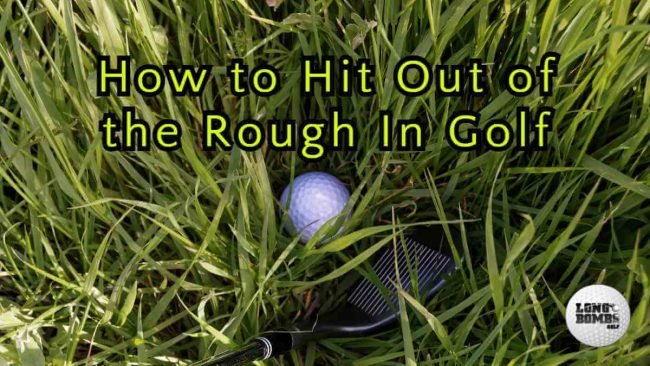
This page uses affiliate links. When you click an affiliate link, we get a small compensation at no cost to you. See Our Affiliate Policy for more info.
What do you do when your ball lands in the rough? Do you know how to hit out of the rough properly? There will be many of times when you find yourself in the rough and you will have to make a great golf shot. This can be a difficult shot, depending on the lie. If you are hitting from a flyer lie, with the ball sitting up on top of the grass, it’s important to take a little loft off the club and swing through gently. If you are hitting from a buried lie, with the ball buried beneath the grass, the setup position and swing will be completely different. Learn more with these tips on how to hit from the rough the correct way!

The rough is made up of taller and thicker grass that surrounds the fairway. This higher and thicker grass can make it difficult to hit the ball cleanly and will penalize you for not hitting the fairway. Most of the time, the rough will cause the ball to travel a shorter distance due to the amount of grass that gets caught between the clubface and the ball. It’s important to note that golfers are NOT allowed to make the ball move around in the rough by pushing on the grass around it. According to the USGA rules, this will cause you a penalty stroke. You can learn more about golf penalty rules here. With that in mind, we will focus on the areas of the course that are easily distinguishable as rough.
The rough is a noticeably thicker area of grass that is not marked as a penalty area. By design, a ball in the rough is harder to hit, encouraging a golfer to aim more intently at a fairway or green. Because the grass in these areas is much longer, it requires a different skill level to strike the ball well. Depending on the length of the rough and how the ball is positioned in it will vastly change the approach you should take.

Hitting from the rough calls for a few fundamental changes in your golf swing to deliver the shot you are looking for. With the rough being much deeper than the grass on the fairway, there are two possibilities where you could be lying. The golf ball could be sitting nice and high on the grass or buried deep in the grass. No matter which of the two you will be facing, there are adjustments that you can make to increase the chances of you getting that GIR. Learn more about what is a GIR in golf here.
If you find yourself in the deeper grass, there are a few key things you want to focus on to get a quality strike.
Take an extra club and move the ball back! The thicker grass will slow your swing and take away some carry distance. Moving from a 7-iron to 6-iron will help you combat some of the lost length without having to swing aggressively and risk losing control. Try to play the ball slightly closer to your trail foot when you address the ball in your setup. The grass will affect your swing speed and contact; moving the ball back will marginally eliminate some resistance. Different types of golf grass on a golf course can affect the way the club face swings through the ball.
Open the club face slightly and stand closer to the ball. The thick grass will grab your club and cause it to close as you swing. Opening the club face slightly will combat the effects this makes on the strike of the golf ball. Be mindful this is a somewhat open club face, do not lay open the club because it will give the result you are looking for. Standing closer to the ball will force your swing to steepen naturally as the golf club handle will move into a more verticle position.
You won’t have to think about this much because the move closer isn’t to a point where you are uncomfortable. The steeper angle of attack will allow you to get to the ball with the least amount of grass interfering with the swing. Depending on the lie, you may need to grip down on the handle of the club as you step closer.

Adjust your aim accordingly. Assuming you are on a flat lie in the rough, you will not need to make many adjustments left or right of your target. Even though you have opened the club face slightly, as your club travels through the rough, the drag will cause the face to close, bringing you back to square. However, the grass between your ball and the club will affect the spin produced from the shot.
Lower backspin will cause the ball to travel more after it hits the ground, rolling out a longer than usual total distance. To prep for this, aim short of your desired target. The further you are away, the more roll you will see. Make a judgment call based on your knowledge of your game and your known distances.
Swing confidently. This is possibly the most critical piece of playing a ball out of the deep rough. It would be best if you struck the ball with intention. A swing with weak velocity or poor follow-through will result in a ball that sadly rolls 20 feet in front of you—possibly not even making it out of the rough. Grip your club firmly and swing the club with controlling authority. Learn more on how to grip your golf club here.
If you effectively take the time before your swing and address the shot’s elements appropriately, you will be delighted with the outcome.
A ball down in the rough can use the ground for assistance if a golfer has failed to control the low point in their swing. If the ball is sitting high up on top of thick rough, the club can pass right under the ball if you misjudge the low point of your swing. This will send the ball sky high and short, or even worse, take a considerable chunk of rough leaving the ball to drop straight down to the ground. For me, this is the worse of the two options.

Take less club. If you have ever heard of a “flyer lie,’ this is what golfers were talking about. A ball with low spin will travel further and roll out more after contact. With the ball sitting high on the rough, there is no ground below the ball to help with compression, which generates less spin on the golf ball.
At address, you simply want to grip down on the club slightly with the ball positioned more toward the center of your stance. Gripping down will help your low point in your swing by shortening the club. If you line up as you usually would, the club will not be able to reach as far as it does in your standard swing. This will help eliminate a strike that goes under the ball.
Swing like you’re holding the driver. I am sure that doesn’t make sense, but let me explain. As you know, the driver swing and a pitching wedge swing are on different plains, primarily because of the club length, draw vs fade, etc. When we talked about a ball deep in the rough, we wanted to create a steep angle of attack; for this scenario, we wanted the opposite. For the shot, try to flatten your swing path as you would see with your driver’s swing. This will again combat the possibility of swinging under the ball, resulting in a fat shot that falls short of the target.
We’ve all been there! Take the time to think about your shot and the golf ball’s lie. If you can plan and prepare better for any golf swing, the result will surely improve. So, whether your ball is sitting up or buried below the grass, make sure you follow these tips to hit out of the rough perfectly every time.